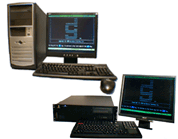|
OCM-1000/2000-Office Communications Manager
OCM-1000/2000-Office Communications Manager
The OCM-1000 and OCM-2000 are powerful, cost-effective TDM networking platforms. The OCM-1000 provides point-to-point and point-to-multipoint connectivity to small and medium sized branch sites. The OCM-2000 extends the TMS-3000 backbone network's capabilities to remote branch office locations. Both OCM platforms offer connectivity to a variety of digital carrier services, allowing users to select the one with the best performance/cost ratio in each location. They use the same bandwidth optimization techniques as the TMS-3000 to efficiently transport voice and data traffic.
OCM Highlights
- Support for a variety of digital services ensures easy implementation of global networks
- Integration of both traditional voice and data and LAN to WAN internetworking, video conferencing and imaging over common digital facilities
- Multi-aggregate capability for resilient mesh networks with diverse routing options
- Configuration and management from a single central-site platform
- Exceptionally high quality voice compression options
- Easy migration path from OCM-1000 to OCM-2000
Network Management
GTS 5.x Platform 
GDC's GTS 5.1 is a Pentium 4 based platform that is backward compatible and supports all the option cards and modules associated with previous TMS software version GTS 2.2. In addition, GTS 5.1 supports LAN connectivity for Telnet and LAN-based logins and provides SNMP alarm traps.
GTS 6.x Software
General DataComms TMS Software (GTS) Version 6.x is an intuitive network management system that provides end-to- end network configuration, control, alarm reporting, and diagnostics of the TMS-3000 network. The GTS software is installed on the PC-based hardware platform and runs on the Linux operating system with MySQL database software.
GTS software communicates with GDCs TMS-3000, OCM- 2000 and MINIMUX nodes from the backbone network. Up to six controllers can be supported on each network, allowing management functions to be performed at several locations. An Ethernet interface to the TMS network is also supported for LAN-based logins.
GTS maximizes network performance and reliability, assuring user access to the network. Intelligent Automatic Rerouting (IAR) and Disaster Recovery and Reconfiguration (DRR) protect and re-establish communications in the event of line/data center failures.
GTS 6.x Highlights
- Global digital connectivity - narrowband, wideband, fractional and hybrid access
-
Supports Linux-based operating system with MySQL database on a PC-based hardware platform.
-
Six controllers per network
-
Intelligent Automatic Routing
-
Time of Day Reconfiguration
-
Disaster Recovery Routing
-
Offline modeling
-
Full SNMP V3 sets, gets and traps
-
Total network backup via CDRW/USB
SNMP Support
The GTS software also supports the SNMPv3 compatible GET, SET and TRAP based configuration, alarm reporting, diagnostics, and management interface. Once configured with SNMP host destinations, the controller will transmit all alarms generated at the system, node, device, port, channel, circuit, diagnostic and operator levels. From 8 to 16 OIDs are associated with each alarm, depending on the alarm trap type. All alarm traps provide alarm name, description, associated TMS element, activation time, alarm level (Critical, Major, Minor or Warning), status (Active or Clear) and the alarm clear time.
Datasheets
 Universal Data Card Universal Data Card
 Universal Voice Card Universal Voice Card
 TMS Compact TMS Compact
 MiniMux MiniMux
 OCM 2000 OCM 2000
 OCM-1000 Hybrid Access Networking Device OCM-1000 Hybrid Access Networking Device
 GTS 6.x Controller Software GTS 6.x Controller Software
 GTS 5.1 Controller GTS 5.1 Controller
|

